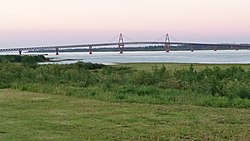Top Qs
Timeline
Chat
Perspective
Fort Providence
Hamlet in Northwest Territories, Canada From Wikipedia, the free encyclopedia
Remove ads
Fort Providence (Slave: Zhahti Koe, Zhahti Kue, lit. 'mission house'[pronunciation?]) is a hamlet in the South Slave Region of the Northwest Territories, Canada. Located west of Great Slave Lake, it has all-weather road connections by way of the Yellowknife Highway (Great Slave Highway) branch off the Mackenzie Highway, and the Deh Cho Bridge opened November 30, 2012, near Fort Providence over the Mackenzie. The bridge replaced the ice bridge and ferry, enabling year-round crossing of the river.
Fort Providence hosts the annual Mackenzie Days celebrations in August each year.
Remove ads
History
Fort Providence was founded in the 1860s as a Catholic mission site. By 1868, the Hudson's Bay Company, which previously has a trading post at Big Island at the source of the MacKenzie River, moved the post to the location of the mission site. From that moment, the settlement was known as Fort Providence. In 1867, the Grey Nuns opened a boarding school and an orphanage in the settlement. Instruction languages were English and French, and most of the nuns originated from Quebec.[7]
Remove ads
Demographics
In the 2021 Census of Population conducted by Statistics Canada, Fort Providence had a population of 618 living in 256 of its 292 total private dwellings, a change of -11.1% from its 2016 population of 695. With a land area of 255.49 km2 (98.65 sq mi), it had a population density of 2.4/km2 (6.3/sq mi) in 2021.[15]
In 2016, the majority of its population, 620, were Indigenous people, made up of 590 First Nations, Dene people, and 30 Métis.[2]
Remove ads
First Nations
The Dene of the community are represented by the Deh Gáh Got'ı̨ę First Nation[17] and the Métis by Fort Providence Métis Nation.[18] Both groups belong to the Dehcho First Nations.[19]
Gallery

- Fort Providence Health Centre
- Our Lady of Providence RC Mission in Fort Providence
- Providence Mission Indian Residential School showing new Roman Catholic Mission on the left, circa 1930
- Fort Providence Deh Cho Land Use Planning Committee & Dene Fur Clouds sign
- The Merv Hardie ferry in use before the bridge was opened.
- The Deh Cho Bridge
Climate
Summarize
Perspective
Fort Providence has a continental subarctic climate (Dfc) typical of the Northwest Territories' populated areas. It is marked by a long cold winter season and short, warm summers, that in many ways are warmer than expected for an area so far north. Transition seasons are extremely short, with temperatures rising and falling quickly in respective seasons.
Remove ads
See also
References
External links
Wikiwand - on
Seamless Wikipedia browsing. On steroids.
Remove ads









